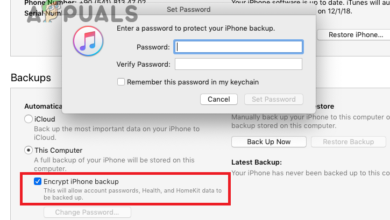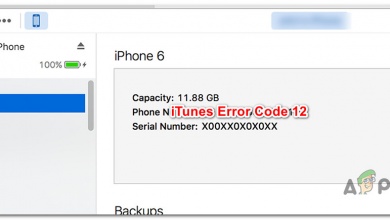Error Code 0x80090318 When Accessing the iTunes Store Website
The error code 0x80090318 is occurring for Windows Users when they attempt to access the iTunes Store website from within the iTunes application. Other users are reporting that the problem is also occurring when they attempt to sync an Apple device, when they attempt to make a purchase or when they attempt to access their Apple music library.
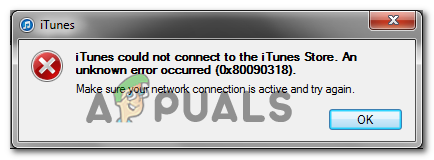
As it turns out, there are several different potential culprits that might be responsible for the apparition of the 0x80090318 error code:
- DNS Cache Inconsistency – As it turns out, this error code can be facilitated by an inconsistency between iTunes and an external app server. In this case, you should use an elevated Command prompt to flush the DNS cache and force your router to assign new values.
- Network Adapter glitch – It’s also possible that 0x80090318 error is caused by a glitch with your network adapter. Several affected users have confirmed that performing a windsock reset (clearing the temporary files of your network adapter) procedure on your router.
- Corrupted iTunes installation – Under certain circumstances, this problem can also occur due to some kind of corruption having to do with the iTunes installation folder (or some dependency). In this case, you should be able to resolve the issue by reinstalling the desktop program or the UWP app.
Method 1: Flushing the DNS Cache
As it turns out, the 0x80090318 error code can be caused by a DNS (Domain Name System) network inconsistency which actually ends up affecting communications between iTunes and the external app server.
If this scenario is applicable, try using an elevated Command Prompt to create a DNS cache. Several affected users have confirmed that this potential fix allowed them to resolve the issue and clear the 0x80090318 error code from iTunes.
If you’re uncertain on how to flush the DNS cache on Windows, follow the instructions below:
- Press Windows key + R to open up a Run dialog box. Next, type ‘cmd’ inside the text box, then press Ctrl + Shift + Enter to open up an elevated Command Prompt. Once you are prompted by the UAC (User Account Control), click Yes to grant administrative privileges.

Running the Command Prompt - Once you’re inside the elevated Command Prompt window, type the following command and press Enter to flush the DNS cache on your computer:
ipconfig/flushdns
Note: What this command essentially does is it removes all information that is currently stored in the DNS cache, forcing the router to assign brand new information.
- After the operation is completed successfully, go ahead and close the elevated command prompt, then repeat the action that was currently causing the iTunes error and see if the issue is now resolved.

Example of a successfully flushed DNS Resolver Cache
In case the same problem is still occurring, move down to the next potential fix below.
Method 2: Refreshing the Network Adapter
If the first potential fix didn’t help, you should take the steps to resolve a different type of inconsistency (one that is caused by the network adapter). Several affected users that were previously facing the same 0x80090318 error code have confirmed that the issue was resolved entirely after they performed a windsock reset (cleared the temporary files of the network adapter).
In the event that an inconsistent network adapter is indeed causing this particular error code, the instructions below should help you refresh the network adapter and fix the issue:
Note: The steps below should work regardless of your Windows version.
- Press Windows key + R to open up a Run dialog box. Next, type ‘cmd‘ and press Ctrl + Shift + Enter to open up the elevated Command Prompt terminal. At the User Account Control prompt, click Yes to grant Admin Access.

Running Command Prompt - Once you’re inside the elevated Command prompt, type the following command and press Enter to refresh the network adapter on your computer:
netsh winsock reset
- After the command is successfully processed, restart your computer and launch iTunes once the next startup is complete to see if the problem is fixed.
In case the same 0x80090318 error is still occurring, move down to the next potential fix below.
Method 3: Reinstalling iTunes
If none of the two potential fixes above have allowed you to fix the issue, there’s a big chance that the problem you’re dealing with is actually facilitated by some kind of corruption originating from the iTunes installation folder (or some associated dependency).
In this case, reinstalling the iTunes program or UWP app should allow you to clear the 0x80090318 error and access the Store, the Music Library, or the syncing of devices.
However, depending on the type of application that you’re currently using (classic desktop program or newer UWP app), the fix for this particular issue will be different.
In case you are using the desktop app, you will need to use the Programs and Features menu to reinstall iTunes using the official channels. In the event that you’re using the UWP (Universal Windows Platform) version on Windows 10, you should be able to fix the issue by resetting the app via the Windows Store.
To accommodate both scenarios, we created 2 separate sub-guides, so feel free the one that’s compatible with the type of iTunes application that you’re using:
A. Reinstalling the Desktop version of iTunes
- Press Windows key + R to open up a Run dialog box. Next, type ‘appwiz.cpl’ inside the text box, then press Enter to open up the Programs and Features menu.

Type appwiz.cpl and Press Enter to Open Installed Programs List - Once you’re inside the Programs and Features menu, scroll down through the list of applications, then right-click on the iTunes app and click on Uninstall from the context menu. At the next prompts, follow the instructions to complete the uninstallation.
- Once the main iTunes application is uninstalled, you should proceed to uninstall every associated component that is published by Apple to make sure that they aren’t any remnant files that might still cause this behavior. To make sure that you’re not missing out or anything, click on the Publisher column, then go ahead and uninstall everything signed by Apple .Inc.

Click the Publisher column to order the app results - Once the operation is complete, restart your computer and wait for the next startup to complete.
- After your computer boots back up, visit the iTunes download page and look for the latest iTunes version for Windows (under Looking for other versions).

Downloading the desktop version of iTunes - Once the latest version of iTunes is reinstalled, reboot your computer once again and see if the problem is fixed at the next computer startup.
B. Reinstalling the UWP version of iTunes
- Press Windows key + R to open up a Run dialog box. Next, type ‘‘ms-settings:appsfeatures” and press Enter to open up the Apps & Features tab of the Settings app.
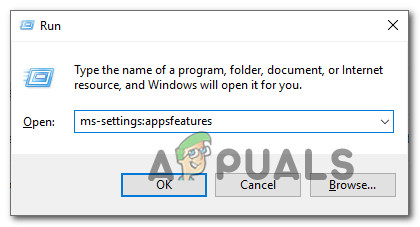
Accessing the Apps & Features menu of the Settings app - Inside the Apps & Features menu of Windows 10, use the search function at the top of the screen to find the iTunes entry (or scroll down through the list of installed UWP applications).
- Next, from the list of results, click on the Advanced Options hyperlink associated with iTunes.
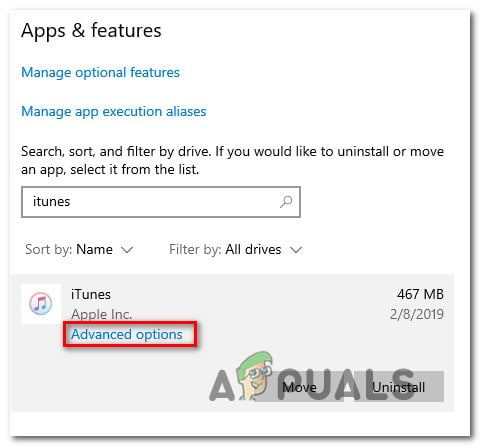
Accessing the Advanced Options menu of iTunes - Inside the Advanced menu of iTunes, scroll down to the Reset tab, then click on Reset button.
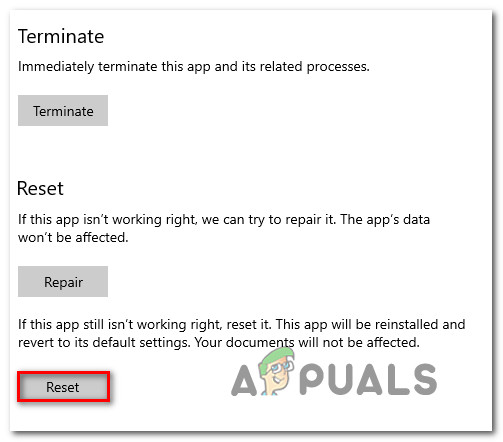
Resetting the iTunes app - At the confirmation prompt, click Reset to start the operation, then wait for the operation to complete.
Note: This operation will revert the iTunes UWP app to the initial state (every associated component will also be reinstalled). - Once the operation is complete, launch iTunes again and see if the 0x80090318 error is fixed.



